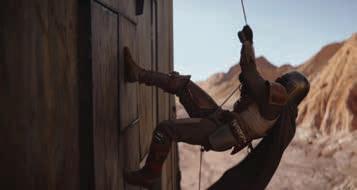
4 minute read
Tech Column
Tech Column Virtual Sets Merge Digital Game Engines with Cinematography
Still from The Mandalorian.
The Mandalorian, the Disney series now streaming, has created a buzz far beyond its entertainment value. What cinematographers are talking about – and by extension crews, directors, producers and post – is how it has used an emerging form of virtual production technology to create stunning vistas and backdrops. Virtual productions have been around for a long time, of course, from projected backdrops, to green screens, CG and motion capture, but this is a leap beyond. This incarnation uses a wall of large high-resolution LED screens to display a seamless background. Make no mistake, however, these aren’t your sports arena Jumbotrons. These are extremely large, high-res LCD or OLED walls and, of course, extremely expensive. The result is fine pixel screens that match up with large sensor capture on tight shots. Also, the screens produce a light of their own so the set lighting, especially the key light, has to be adjusted accordingly. Second, the vista is not static. It is programmed to have 3D depth and perspective. So as the actors move in front of the screens and the camera perspective tracks left or right or up or down, the perspective of the background also shifts in a much more realistic way. The technology is not new in that it has been developed by the video game industry over many years of creating immersive, role-playing games. In fact, the ILM version uses the game engine from Epic, creator of titles like Fortnite and Infinity Blade and Unreal, the now vintage first-person shooter game that spawned the game engine of the same name, Unreal Engine, now in its fourth iteration. It’s a complete suite of software with all the tools developers need to create their own worlds, whether for gaming or, now, cinematography. It’s also being increasingly used in virtual reality productions, training videos, commercials and animation productions. In movie making, the technology has shifted from being used to design 3D concepts of sets to allow the director and DP a “virtual reality” walkthrough to actually becoming the sets via Stagecraft. Generically, it’s known as virtual production, but ILM jumped the gun and has branded its version as Stagecraft – from stagecraft – the process of building sets and staging in live theatre, but this technology is light years ahead of its roots. It’s also a galaxy far, far beyond predecessor technologies like green screen or back projection. In its virtual production field guide, Epic Games says: “…… (it’s) like parallel processing. It removes the barriers between live production and visual effects, so that they can occur simultaneously instead of inline.” For camera and lighting makers, this is a game changer, says ARRI President Glenn Kennel. “Yes, we’re following this, and we are working with the people involved like ILM and Epic Games because we are interested in integrating our cameras and lighting equipment for it,” he says. The freedom of being able to virtually create a set is liberating, he allows, but that’s offset by the cost. It’s not cheap. Mandalorian racks up $15 million an episode, according to some reports, and that price tag alone will put it out of reach for many productions, at least initially. But these are early days, Kennel says, and despite the sticker price shock, there are some ways to offset them. “You will need people on set trained to work with this technology specifically, program it and adjust it,” he says. “But a lot of the work being done in post can move to capture.” In the Epic field guide, Zach Alexander, founder and COO of Lux Machina, put it this way: “Every hour of preproduction is worth two hours of production.” There’s a learning curve too, Kennel says, with all stakeholders now looking at how this is going to affect them. ARRI, he says, is looking at issues like refresh rates for the screen and flicker issues, which may affect cameras. Also, which of their lighting lineup works best in the virtual setup and whether any technology changes need to be made to better synch with the new systems. “The benefit is that it’s What-You-See-Is-What-You-Get, the actor, the director, everyone sees it, unlike a green screen,” he says. “the cinematographer sees it and can adjust the lighting in the foreground and background.” With programmable LEDs, the lighting can be tweaked in real time on set, ultimately speeding up the process somewhat, he adds. And, as new technology roots, it makes old technology obsolete. Libraries full of static backgrounds will give way to moving vistas in 360, which will need to be captured and archived as demand grows. It’s not hard to see the synergistic benefit that accrues to game makers who can also pull those background captures for their own offerings.
Ian Harvey is a journalist who has been writing about digital disruption for 20 years. He welcomes feedback and eagerly solicits subject matter ideas at ian@pitbullmedia.ca.




